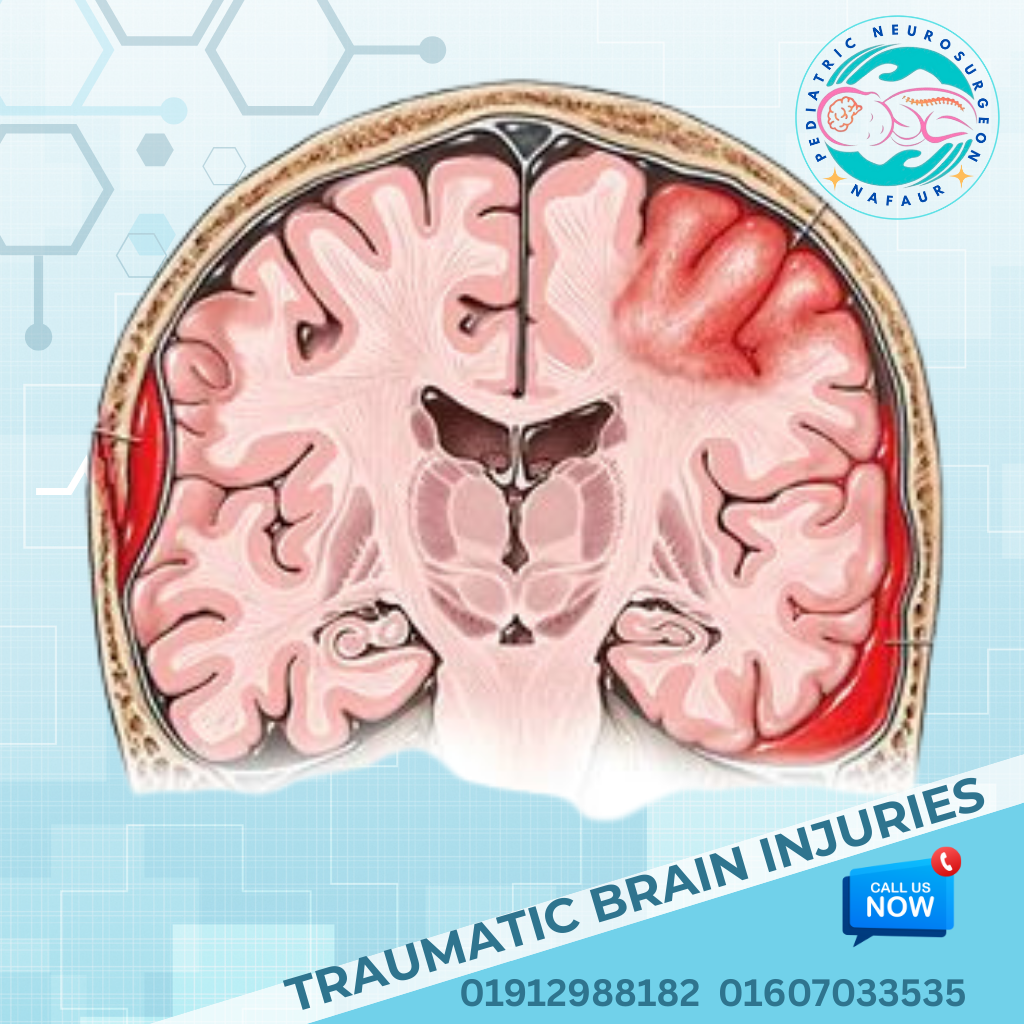Traumatic Brain Injuries
Traumatic Brain Injuries
Pediatric Traumatic Brain Injuries (TBI) refer to any damage to a child’s brain caused by an external mechanical force such as a fall, road traffic accident, sports injury, or impact with a sharp or blunt object. Depending on the severity, TBIs can range from mild concussions to life-threatening cerebral hemorrhages or skull fractures. In Bangladesh, pediatric TBIs are a growing public health concern due to increasing urban density, road hazards, unsafe home environments, and lack of awareness regarding child safety. Early intervention by a skilled pediatric neurosurgeon like Dr. Md. Nafaur Rahman can significantly reduce the risk of disability, developmental delay, and death. 🚨 Common Causes of TBI in Bangladeshi Children In the Bangladeshi context, the following are common causes of pediatric brain injuries: 🚗 Road Traffic Accidents (RTAs) – Especially motorcycle or rickshaw incidents involving unprotected children 🧱 Falls from rooftops, beds, or trees – A common cause in both urban and rural homes 🏏 Sports-related injuries – Particularly from cricket, football, or school activities 🧊 Domestic accidents – Slipping on floors or staircases, head injuries from sharp objects 🔫 Penetrating trauma – Accidents with tools or rare cases of violence 🧔 Non-accidental trauma (child abuse) – A hidden but critical issue often misdiagnosed 🧠 Types of Pediatric Traumatic Brain Injuries Pediatric TBIs can present in different forms, including: 1. Concussion (Mild TBI) Temporary loss of brain function Common symptoms: headache, confusion, nausea, irritability Often underreported in Bangladesh due to cultural neglect 2. Contusion Bruising of brain tissue due to direct impact Can lead to swelling and localized neurological issues 3. Skull Fractures Linear, depressed, or basilar fractures May be associated with bleeding, CSF leak, or infection risk 4. Intracranial Hemorrhages Epidural, subdural, subarachnoid, or intraparenchymal bleeding Life-threatening; requires urgent surgical intervention 5. Diffuse Axonal Injury (DAI) Caused by rapid acceleration/deceleration (e.g., vehicle crash) Leads to widespread brain damage and coma in severe cases 6. Penetrating Brain Injuries Foreign object enters the skull Requires meticulous surgical removal and infection control ⚠️ Warning Signs & Symptoms Early recognition of TBI symptoms is crucial. Children may exhibit: Loss of consciousness or fainting Vomiting more than once Seizures or jerking movements Lethargy or drowsiness Bulging of the soft spot (in infants) Slurred speech or confusion Unequal pupils or vision changes Bleeding or clear fluid from nose or ears In Bangladesh, many of these signs are often misinterpreted, delaying life-saving intervention. 🏥 Diagnosis: Expert Protocol at NINS & BP Neurocare Dr. Nafaur Rahman follows a time-sensitive and child-friendly diagnostic protocol, including: CT Brain Scan (Non-contrast) – First-line for acute trauma MRI Brain – Especially for long-term effects or DAI X-Ray Skull/Spine – To detect fractures ICP Monitoring – In moderate to severe TBIs Neurosonography – For infants with open fontanelle Blood Tests & Infection Markers Every child receives personalized assessment based on age, GCS score, and trauma mechanism. 🛠️ Neurosurgical Management of TBI In moderate to severe TBI cases, surgery may be necessary to: Evacuate hematomas (epidural, subdural, intracerebral) Control brain swelling (decompressive craniectomy) Repair skull fractures and dural tears Place VP shunts for post-traumatic hydrocephalus Remove foreign bodies in penetrating injuries “A child’s developing brain deserves urgency, precision, and compassion. That’s our commitment at every step.” — Dr. Md. Nafaur Rahman 🔄 Post-Surgical Care & Rehabilitation Following neurosurgical intervention, children require: Pediatric ICU support with neuro-monitoring Anticonvulsants for seizure prevention Respiratory and nutritional management Rehabilitation programs tailored to the child’s deficits 🧒 Long-Term Complications & Support Even mild injuries can lead to long-term effects if ignored. Dr. Nafaur’s team helps children recover from: Speech and language delay Cognitive impairment or learning disability Behavioral changes (ADHD-like symptoms, aggression) Post-traumatic epilepsy Visual or motor deficits Early neurodevelopmental therapy, counseling, and academic reintegration support optimal recovery. 🌍 Bangladesh-Specific Challenges & Solutions Common Issues: 🚑 Delayed transportation to tertiary centers ❌ Lack of child safety laws or helmet enforcement 🧭 Low public awareness in rural and urban slums 👩⚕️ Inadequate pediatric trauma training among first responders Dr. Nafaur Rahman’s Efforts: Training programs for emergency doctors and GPs on early referral Public awareness campaigns on head injury signs Partnerships with NGOs to subsidize imaging and surgery for underprivileged families Advocacy for national pediatric head injury registry 👨⚕️ Why Choose Dr. Md. Nafaur Rahman? 🧠 Renowned specialist in pediatric neurosurgical emergencies 🏥 Practices at NINS, Bangladesh’s premier neuroscience center 👶 Uses child-friendly diagnostic, surgical, and therapeutic tools 🎯 Focuses on both life-saving treatment and long-term neurodevelopment 📈 Trusted by parents and physicians for complex pediatric brain trauma care 📞 Contact for Pediatric TBI Emergency or Consultation Dr. Md. Nafaur Rahman Assistant Professor, Pediatric Neurosurgery, NINS Chief Consultant, Bangladesh Paediatric Neurocare Centre 📱 For Serial/Appointment: 📞 01912988182 | 📞 01607033535 🌐 Website: www.neurosurgeonnafaur.com
Common Traumatic Brain Injuries










